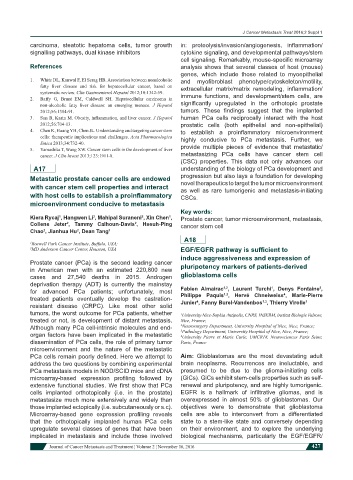Page 437 - Read Online
P. 437
J Cancer Metastasis Treat 2016;2 Suppl 1
carcinoma, steatotic hepatoma cells, tumor growth in: proteolysis/invasion/angiogenesis, inflammation/
signalling pathways, dual kinase inhibitors cytokine signaling, and developmental pathways/stem
cell signaling. Remarkably, mouse-specific microarray
References analysis shows that several classes of host (mouse)
genes, which include those related to myoepithelial
1. White DL, Kanwal F, El Serag HB. Association between nonalcoholic and myofibroblast phenotype/cytoskeleton/motility,
fatty liver disease and risk for hepatocellular cancer, based on extracellular matrix/matrix remodeling, inflammation/
systematic review. Clin Gastroenterol Hepatol 2012;10:1342-59.
2. Baffy G, Brunt EM, Caldwell SH. Hepatocellular carcinoma in immune functions, and development/stem cells, are
non-alcoholic fatty liver disease: an emerging menace. J Hepatol significantly upregulated in the orthotopic prostate
2012;56:1384-91. tumors. These findings suggest that the implanted
3. Sun B, Karin M. Obesity, inflammation, and liver cancer. J Hepatol human PCa cells reciprocally interact with the host
2012;56:704-13. prostatic cells (both epithelial and non-epithelial)
4. Chen K, Huang YH, Chen JL. Understanding and targeting cancer stem to establish a proinflammatory microenvironment
cells: therapeutic implications and challenges. Acta Pharmacologica highly conducive to PCa metastasis. Further, we
Sinica 2013;34:732-40.
5. Yamashita T, Wang XW. Cancer stem cells in the development of liver provide multiple pieces of evidence that metastatic/
cancer. J Clin Invest 2013;123:1911-8. metastasizing PCa cells have cancer stem cell
(CSC) properties. This data not only advances our
A17 understanding of the biology of PCa development and
Metastatic prostate cancer cells are endowed progression but also lays a foundation for developing
with cancer stem cell properties and interact novel therapeutics to target the tumor microenvironment
as well as rare tumorigenic and metastasis-initiating
with host cells to establish a proinflammatory CSCs.
microenvironment conducive to metastasis
Key words:
Kiera Rycaj , Hangwen Li , Mahipal Suraneni , Xin Chen , Prostate cancer, tumor microenvironment, metastasis,
1
2
2
1
Collene Jeter , Tammy Calhoun-Davis , Hseuh-Ping cancer stem cell
2
2
Chao , Jianhua Hu , Dean Tang 1
2
2
A18
1 Roswell Park Cancer Institute, Buffalo, USA;
2 MD Anderson Cancer Center, Houston, USA EGF/EGFR pathway is sufficient to
induce aggressiveness and expression of
Prostate cancer (PCa) is the second leading cancer
in American men with an estimated 220,800 new pluripotency markers of patients-derived
cases and 27,540 deaths in 2015. Androgen glioblastoma cells
deprivation therapy (ADT) is currently the mainstay 1,2 1 2
for advanced PCa patients; unfortunately, most Fabien Almairac , Laurent Turchi , Denys Fontaine ,
Philippe Paquis , Hervé Chneiweiss , Marie-Pierre
4
1,2
treated patients eventually develop the castration- Junier , Fanny Burel-Vandenbos , Thierry Virolle 1
4
1,3
resistant disease (CRPC). Like most other solid
tumors, the worst outcome for PCa patients, whether 1 University Nice-Sophia Antipolis, CNRS, INSERM, institut Biologie Valrose,
treated or not, is development of distant metastasis. Nice, France;
Although many PCa cell-intrinsic molecules and end- 2 3 Neurosurgery Department, University Hospital of Nice, Nice, France;
Pathology Department, University Hospital of Nice, Nice, France;
organ factors have been implicated in the metastatic 4 University Pierre et Marie Curie, UMCR18, Neurosciences Paris Seine,
dissemination of PCa cells, the role of primary tumor Paris, France
microenvironment and the nature of the metastatic
PCa cells remain poorly defined. Here we attempt to Aim: Glioblastomas are the most devastating adult
address the two questions by combining experimental brain neoplasms. Recurrences are ineluctable, and
PCa metastasis models in NOD/SCID mice and cDNA presumed to be due to the glioma-initiating cells
microarray-based expression profiling followed by (GiCs). GiCs exhibit stem-cells properties such as self-
extensive functional studies. We first show that PCa renewal and pluripotency, and are highly tumorigenic.
cells implanted orthotopically (i.e. in the prostate) EGFR is a hallmark of infiltrative gliomas, and is
metastasize much more extensively and widely than overexpressed in almost 50% of glioblastomas. Our
those implanted ectopically (i.e. subcutaneously or s.c). objectives were to demonstrate that glioblastoma
Microarray-based gene expression profiling reveals cells are able to interconvert from a differentiated
that the orthotopically implanted human PCa cells state to a stem-like state and conversely depending
upregulate several classes of genes that have been on their environment, and to explore the underlying
implicated in metastasis and include those involved biological mechanisms, particularly the EGF/EGFR/
Journal of Cancer Metastasis and Treatment ¦ Volume 2 ¦ November 16, 2016 427

